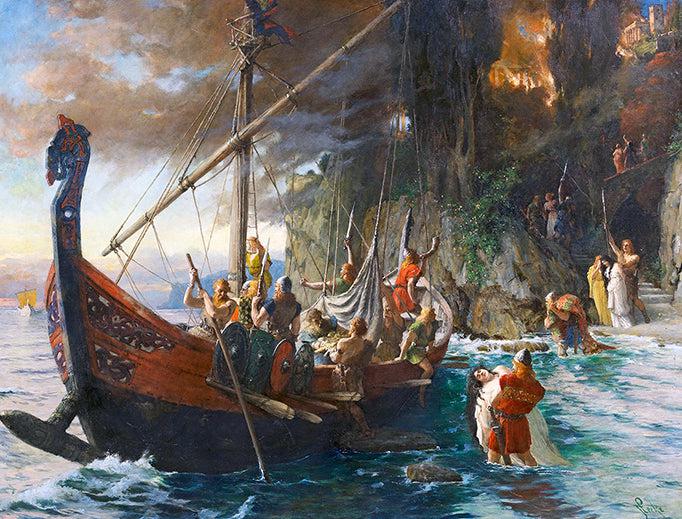What were the Viking raids like?

Brief overview of the Vikings and their reputation as fierce raiders
The Vikings were a seafaring people from the late eighth to the early 11th century. They hailed from the Scandinavian countries of Norway, Denmark, and Sweden, and their journeys and raids took them as far as North America, Africa and Asia. The Vikings were known for their fierce and ruthless raids on monasteries, towns, and cities throughout Europe, earning them a reputation as fierce warriors and brutal raiders.
The Vikings used their superior naval technology, specially the longships, to their advantage, these ships allowed them to navigate shallow waters, travel in rough sea conditions, and launch sudden and unexpected attacks on their victims. Their raids were characterized by speed and surprise, which made it difficult for the people to defend themselves. The Vikings would often loot, plunder and burn down towns, taking captives and leaving behind a trail of destruction.
In addition to their raids, the Vikings also engaged in trade and diplomacy, and established settlements in many of the areas they visited. Their settlements and trading posts had a lasting impact on the cultures and societies they encountered, particularly in the British Isles, where they established the Danelaw in England. The Viking Age, as the period of their expansion and raids is known, had a significant impact on the early Middle Ages and on the subsequent development of Europe. Although often remembered for their raiding, the Vikings were also a complex and diverse people with a rich culture and a deep sense of community.
Types of locations the Vikings raided, including monasteries, towns, and cities
The Vikings were known for their raids on a wide range of targets, including monasteries, towns, and cities. Monasteries were particularly vulnerable, as they were often located in remote areas and were rich in treasure and valuables such as gold, silver, and religious artifacts. The Vikings would often target monasteries because they knew the monks would not put up much of a fight and would be able to plunder and loot easily. Towns and cities were also raided by the Vikings, as they were often prosperous and held valuable resources such as food, weapons, and slaves.
In addition to these types of settlements, Vikings also targeted coastal towns, river towns and trading centers, as well as small villages. They also attacked on ships, especially in the Mediterranean and along the coast of Western Europe. They took slaves, looted treasures and enriched themselves by demanding huge ransoms from the towns and cities they attacked.
It's worth noting that not all Viking raids were violent, some were more like trading expeditions where they were welcomed by the locals and traded peacefully. However, the reputation of Vikings as fierce raiders have been widely spread and perpetuated by historical accounts, which have exaggerated the violence and brutality of their raids.
Vikings' tactics and methods, such as surprise attacks and the use of longships
One of the key strategies Vikings used was the element of surprise. They would often launch attacks at unexpected times, such as in the early morning or at night, and would use the cover of fog, mist or darkness to conceal their movements. They also used diversionary tactics, like feigning retreats or splitting their forces to confuse and disorient their enemies.
The Vikings also employed their superior naval technology, particularly the longships, to great advantage during their raids. These ships were lightweight, fast, and could navigate shallow waters and rough sea conditions. The longships also had a shallow draft, which allowed them to approach close to shore and launch sudden and unexpected attacks. They could be sailed or rowed, this feature gave them a considerable speed advantage over the ships of their opponents.
The longships were also equipped with a wide range of weapons, including shields, swords, axes, and bows, which allowed the Vikings to fight effectively both on land and at sea. The Vikings were a powerful force, both in terms of their technology and their tactics, and this helped them to succeed in many of their raids and gain control over large areas of land.
The impact of Viking raids on the people and societies of Europe, including destruction of property and loss of life
Viking raids had a significant impact on the people and societies of Europe during the Viking age. The raids caused widespread destruction of property, as the Vikings would often loot, plunder, and burn down towns and cities, taking anything of value. This often resulted in the loss of homes, businesses, and livelihoods for the people living in these areas.
The raids also resulted in the loss of life, both through direct violence and through the indirect consequences of the destruction of property and displacement of people. Monasteries were particularly vulnerable, as they were often located in remote areas and were rich in treasure and valuables such as gold, silver, and religious artifacts. The monks who lived in these monasteries were often killed or taken as slaves.
The raids also had a significant economic impact, as trade and commerce were disrupted and resources were drained from the communities that were targeted. Additionally, the fear of Viking raids often led to the fortification of towns and cities, which had further economic and societal impacts.
The raids also had long-lasting cultural and political effects, such as the establishment of the Danelaw in England, which would shape the future political and cultural landscape of these places, also the Vikings also intermarried with local populations and sometimes established their own settlements. Their legacy can still be seen in the place names, cultural influence and genetic heritage of some regions today.
Raids on the British Isles, including Ireland, Scotland, and England
The Vikings had a significant impact on the British Isles, specifically Ireland, Scotland and England. They began raiding the coasts of these islands in the late 8th century, and their attacks continued for several hundred years. The Vikings targeted monasteries and towns along the coast, looting and plundering as they went.
In Ireland, the Vikings established trading settlements, such as Dublin and Limerick, and intermarried with the local population. They also set up fortified towns and trading posts along the coast and rivers, which became the nuclei of new towns. In Scotland, the Vikings conducted raids along the western and northern coasts, establishing settlements such as Orkney and Shetland.
England was also frequently targeted by the Vikings, especially during the late 9th century. They conducted a series of major raids on the Anglo-Saxon kingdoms and successfully conquered a large area of the northeastern part of the country, which became known as the Danelaw. The Vikings established settlements in this area and intermarried with the local population. The Danelaw was a semi-autonomous region within England, with its own legal and administrative systems which was in place until the end of 11th century.
These Viking settlements and raids had a lasting impact on the cultures and societies of the British Isles, particularly in terms of place names, genetic heritage, cultural influences and political development.
Vikings' explorations and raids in Eastern Europe, including Russia and Byzantium
The Vikings also conducted raids and established settlements in Eastern Europe, including Russia and Byzantium. They began their attacks on Eastern Europe in the 9th century, and their raids continued for several hundred years. In Russia, the Vikings established a settlement at Novgorod in the 9th century, and they eventually established the state of Kievan Rus, which became one of the largest and most powerful medieval states in Eastern Europe.
In Byzantium, the Vikings were known as Varangians. They were initially hired as mercenaries but later settled and established a powerful military elite known as the Varangian Guard. They served as the personal bodyguard of the Byzantine Emperors and played an important role in the politics and military history of the Byzantine Empire. They also served as traders and explorers, and many of them settled in Constantinople, the capital of the Byzantine Empire.
The Vikings' explorations and attacks in Eastern Europe had a significant impact on the history and development of these areas. The Varangians played an important role in the Byzantine Empire, helping to shape its politics and military history. The Vikings also established trade routes and settlements, which had a lasting impact on the culture and economy of Eastern Europe. Their legacy in Eastern Europe can still be seen today in place names, language, and cultural influences.
Conclusion
The Vikings were not just raiders, they also engaged in trade and diplomacy in the societies they visited. In Eastern Europe, their interactions with Russia and Byzantium were a mix of trade, diplomacy, and violence.
In Russia, the Vikings established a settlement at Novgorod in the 9th century, which quickly grew into a major trading center. They traded furs, slaves, and amber for silver, silk, and other luxury goods. They also formed alliances with the local tribes and established trading routes, which played an important role in the economy and politics of early Russia.
In Byzantium, the Vikings were known as Varangians and served as mercenaries, traders and explorers. They formed an elite military force, known as the Varangian Guard, and served as the personal bodyguard of the Byzantine Emperors. They played an important role in Byzantine politics and military history, also they traded with the empire, especially in the areas of fur, amber, and slaves.
The Vikings' trading and diplomatic interactions in Eastern Europe allowed them to establish lasting trade routes, alliances, and settlements. Their interactions played an important role in the economy, politics and military history of these societies, and they also served to introduce new technologies, culture and ideas from the Vikings to the Eastern European societies.




